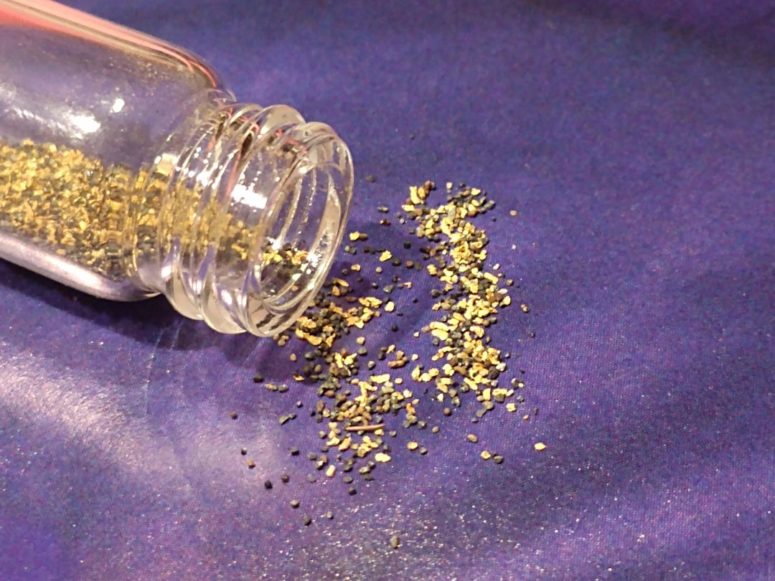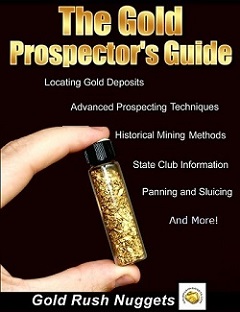
Glaciers were once prevalent across all of the northern states in the USA. During various ice ages over the past millennia, ice has moved downward from the Arctic. In the process, it would push and carry with it rocks and gravels. No surprise that some of this material was valuable ores containing silver and gold.
Anywhere that a glacier once covered the landscape has the potential to have deposited gold, and you might be surprised just how many times large sections of the USA have been covered by ice. Each time glaciers moved south, they would continue the process of transporting and crushing host material.
Because of their continual movement, glaciers brought gold and other minerals within the rock and sediment far beyond where they were originally formed. When glaciers melt due to warmer temperatures, they leave behind boulders and pulverized debris that contain these mineral deposits.
Pulverized Gold Ores = Tiny Gold Dust
Because of the process by which glacial deposits are formed, mining them can prove to be trickier than usual. For example, glacial gold tends to be much finer in texture than regular placer gold that eroded from hard rock deposits. This is because minerals that are stored and transported by glaciers undergo intense pressure and pulverization.
As a glacier advances, it grinds down and erodes the bedrock beneath and in front of the ice. Thus, the deposits within it are also eroded and become smaller and finer.

Widely Distributed & Scattered Deposits
Another factor contributing to the challenge of mining glacial gold is its wide distribution. Alluvial gold is more predictable in terms of its distribution. Gold from veins in hard rock can be identified by studying the surrounding geology. An experienced miner can predict where gold might be found at any given location.
Glaciers, on the other hand, can melt virtually anywhere, distributing the minerals any which way. They don’t leave a pattern or trace that’s easily visible, making the location of the glacial gold a bit more challenging to determine. And since the glaciers spread the material over such a broad area, finding decent concentrations of gold can be quite challenging.
Example:
Let’s consider that a chunk of very rich high-grade gold ore is sitting on a mountaintop in Ontario, Canada. This 100-pound chunk of rock contains 20-ounces of gold. That might sound pretty good, but then imagine that a glacier begins to form and moves down across the Great Lakes region. Of course this process takes thousands of years, but it eventually moves that chunk of ore down into Ohio.
Don’t expect that ore to be intact. The immense pressure of moving that valuable ore has come at a cost… it is now broken into a thousand little pieces. The gold has been crushed and scattered. Not only is that original chunk of ore now in so many pieces, but the movement has scattered it over a large area. 20-ounces of gold that was once concentrated in a basketball-sized rock is now disseminate across an area the size of several football fields… or perhaps even miles.
But we’re not done yet… The glacier that originally brought the gold down has now receded, but a few thousand years passes and now another glacier comes scraping along. It pushes the now scattered gold across an even bigger area, dropping it as it recedes. This process may have happened dozens of times in some areas. You can see how glacial deposits can scatter so widely that its difficult to locate any significant concentrations.
Is Glacial Gold Only Found in the Midwest?
Glaciers scoured hard rock gold deposits in Canada and brought them down all across the United States, but certain areas received better deposits that others. Mostly it is prospectors in the Northeast and Midwestern states that seek out glacial gold deposits. Miners in more traditional gold regions don’t usually give it much attention.
There are two main reasons for this. One is that the areas of Canada where that glacial material comes from is quite rich. In particular are the rich mining regions of Quebec and Ontario. Considerable rich ores would have been brought down. In comparison, places like Alberta, Manitoba and Saskatchewan don’t have much gold, so the material that was pushed down did not contain much gold.
The second reason that prospectors in the Midwest and Northeast focus on glacial gold is because that’s all they really have! The host rock that exists throughout most of this region doesn’t contain gold like areas in the West and Southeast. In contrast, there are parts of Idaho and Montana that were also covered by glaciers and certainly would have gotten some fine gold deposits, but in comparison the the rich gold deposits that already exist there is simply no comparison. A prospector in Idaho is not going to spend time locating scattered glacial gold deposits where there are already rich placers present from local sources.
Read: Crevicing for Gold – Finding Gold in Bedrock Cracks
Terminal Moraines and Known Gold Areas
Choosing a place to start prospecting for glacial gold can be difficult, and might feel like it’s random. But there are a few indicators that can give you an idea of where to start. Think of a glacier like a giant snow plow. It pushes and pushes rocks and debris in front of it for hundreds of miles. When the weather starts warming and the ice begins to recede, a large debris pile is left behind. This is where the heaviest concentrations of gold will be. For those looking to try their hand at hunting down glacial gold, scientific reports on early glaciation can give a clue as to where the moraines are located.
Of course is important to note that the gold placers can also be found in or near rapidly flowing streams and rivers that cut through or drain the moraine deposits, and not always at the moraine itself. The process of erosion never stops! It happens every second of every day.
If this all seems overwhelming, just remember the old adage, “look for gold where it has been found before.” You don’t have to start from scratch… consider joining a prospecting club in your area. Most of the best areas have already been identified, and joining a club might be a great way to quickly learn about the better areas to start your search.
Indeed, the natural world has many interesting phenomena to behold, and glacial gold is one of them. The placers we unearth today as a result of glacial drift have withstood intense temperature, pressure, and millions of years of movement across continents. Imagine that—when holding even the tiniest gold nugget in your palm, you’re grasping millions of years’ worth of Mother Nature’s unpredictable intensity!
Fine Gold Equipment
It is worth mentioning that the extra-fine texture of the gold that you will most often find will require extra care to recover. If you aren’t careful it is easy to lose those tiny specks. Make sure you have the best equipment available for the job.

